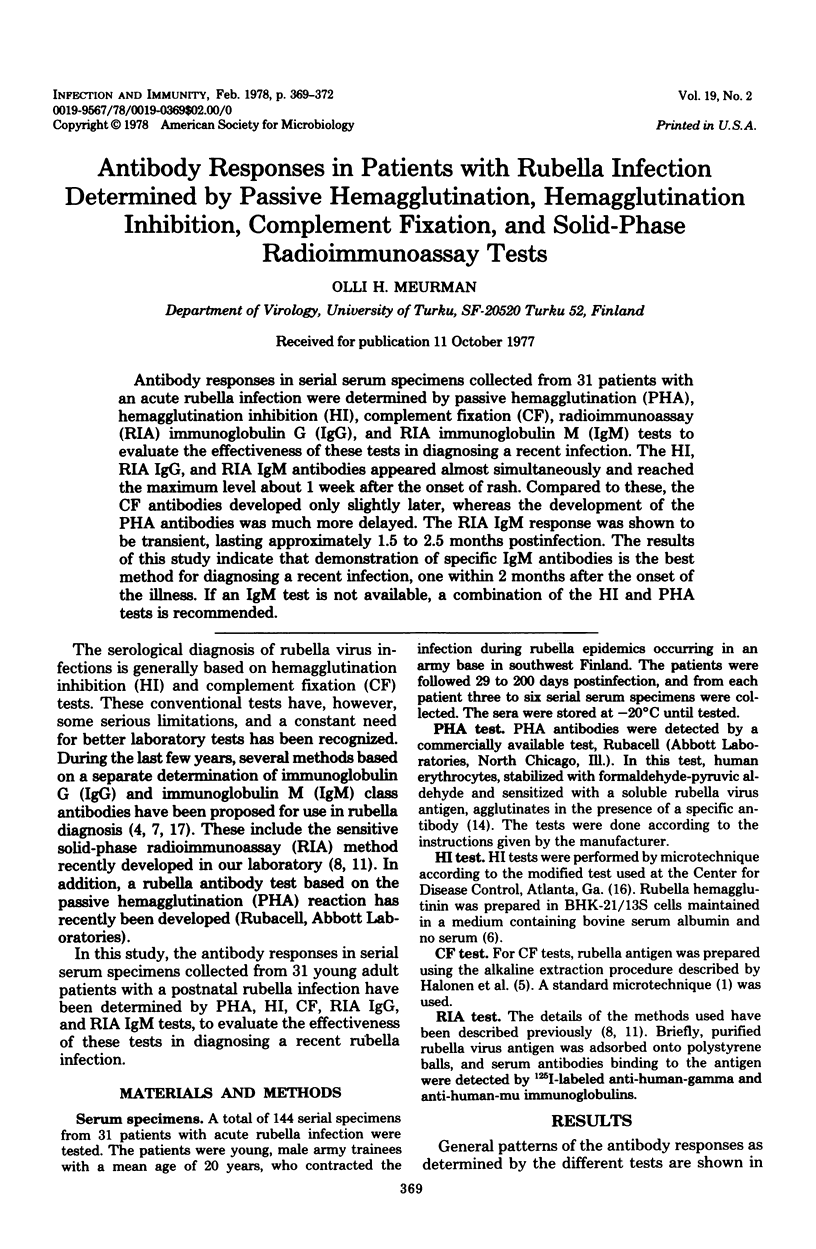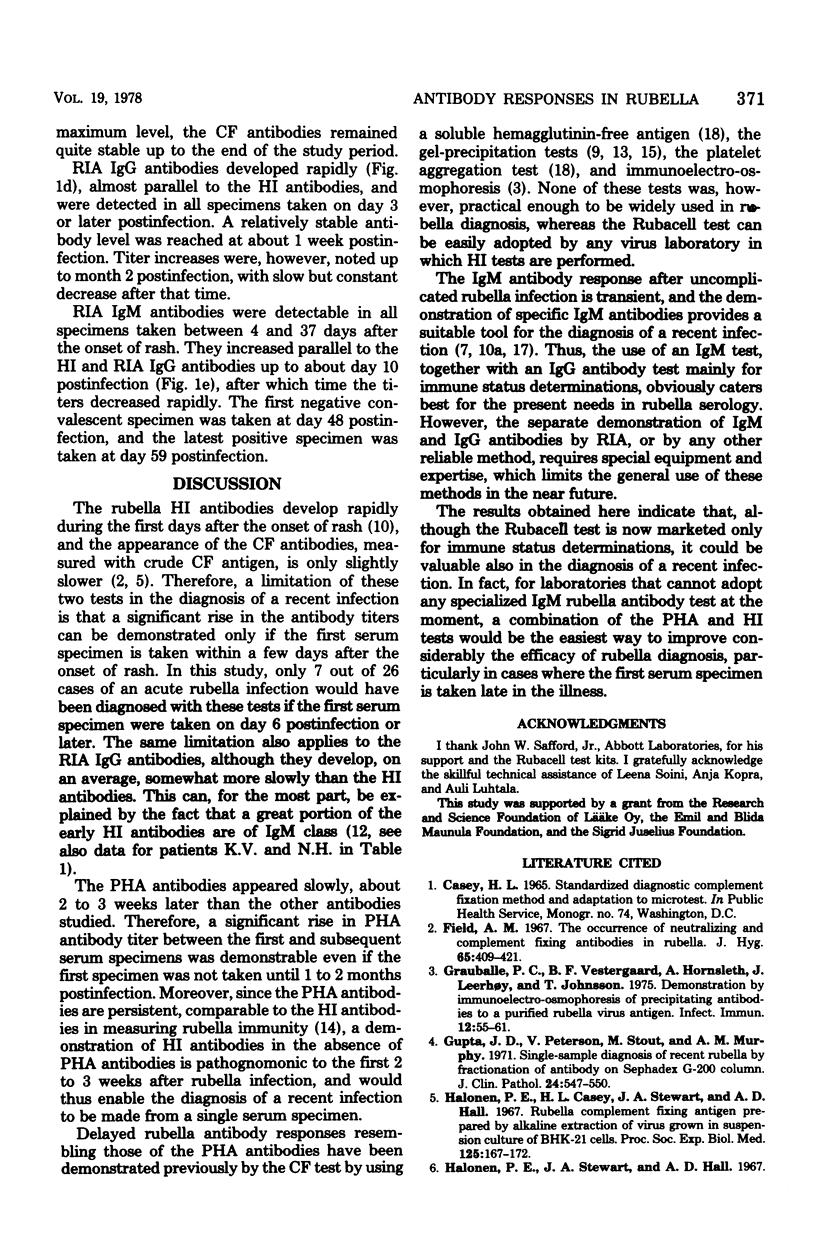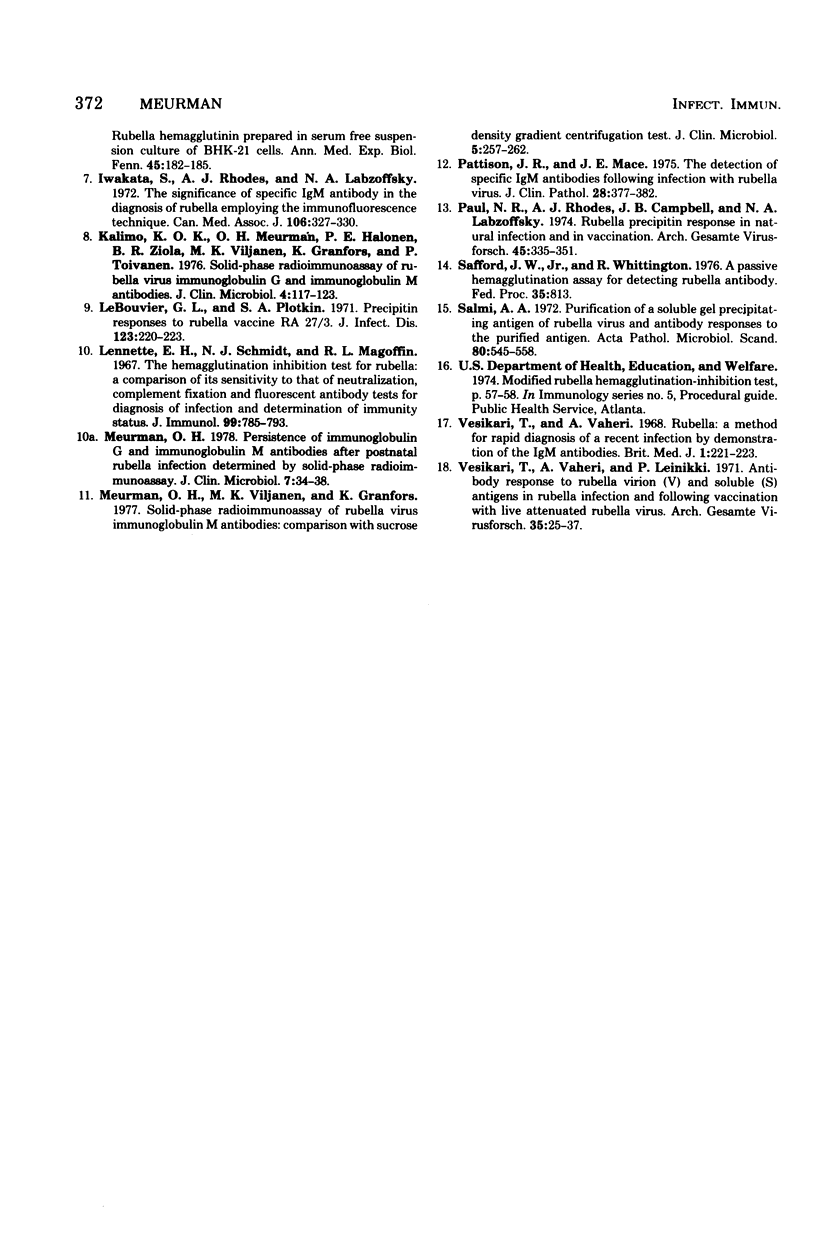Abstract
Antibody responses in serial serum specimens collected from 31 patients with an acute rubella infection were determined by passive hemagglutination (PHA), hemagglutination inhibition (HI), complement fixation (CF), radioimmunoassay (RIA) immunoglobulin G (IgG), and RIA immunoglobulin M (IgM) tests to evaluate the effectiveness of these tests in diagnosing a recent infection. The HI, RIA IgG, and RIA IgM antibodies appeared almost simultaneously and reached the maximum level about 1 week after the onset of rash. Compared to these, the CF antibodies developed only slightly later, whereas the development of the PHA antibodies was much more delayed. The RIA IgM response was shown to be transient, lasting approximately 1.5 to 2.5 months postinfection. The results of this study indicate that demonstration of specific IgM antibodies is the best method for diagnosing a recent infection, one within 2 months after the onset of the illness. If an IgM test is not available, a combination of the HI and PHA tests is recommended.
Full text
PDF



Selected References
These references are in PubMed. This may not be the complete list of references from this article.
- Field A. M. The occurrence of neutralizing and complement fixing antibodies in rubella. J Hyg (Lond) 1967 Sep;65(3):409–421. doi: 10.1017/s0022172400045927. [DOI] [PMC free article] [PubMed] [Google Scholar]
- Grauballe P. C., Vestergaard B. F., Hornsleth A., Leerhoy J., Johnsson T. Demonstration by immunoelectro-osmophoresis of precipitating antibodies to a purified rubella virus antigen. Infect Immun. 1975 Jul;12(1):55–61. doi: 10.1128/iai.12.1.55-61.1975. [DOI] [PMC free article] [PubMed] [Google Scholar]
- Gupta J. D., Peterson V., Stout M., Murphy A. M. Single-sample diagnosis of recent rubella by fractionation of antibody on Sephadex G-200 column. J Clin Pathol. 1971 Sep;24(6):547–550. doi: 10.1136/jcp.24.6.547. [DOI] [PMC free article] [PubMed] [Google Scholar]
- Halonen P. D., Casey H. L., Stewart J. A., Hall A. D. Rubella complement fixing antigen prepared by alkaline extraction of virus grown in suspension culture of BHK-211 cells. Proc Soc Exp Biol Med. 1967 May;125(1):167–172. doi: 10.3181/00379727-125-32039. [DOI] [PubMed] [Google Scholar]
- Iwakata S., Rhodes A. J., Labzoffsky N. A. The significance of specific IgM antibody in the diagnosis of rubella employing the immunofluorescence technique. Can Med Assoc J. 1972 Feb 19;106(4):327–330. [PMC free article] [PubMed] [Google Scholar]
- Kalimo K. O., Meurman O. H., Halonen P. E., Ziola B. R., Viljanen M. K., Granfors K., Toivanen P. Solid-phase radioimmunoassay of rubella virus immunoglobulin G and immunoglobulin M antibodies. J Clin Microbiol. 1976 Aug;4(2):117–123. doi: 10.1128/jcm.4.2.117-123.1976. [DOI] [PMC free article] [PubMed] [Google Scholar]
- Le Bouvier G. L., Plotkin S. A. Precipitin responses to rubella vaccine RA 27-3. J Infect Dis. 1971 Feb;123(2):220–223. doi: 10.1093/infdis/123.2.220. [DOI] [PubMed] [Google Scholar]
- Lennette E. H., Schmidt N. J., Magoffin R. L. The hemagglutination inhibition test for rubella: a comparison of its sensitivity to that of neutralization, complement fixation and fluorescent antibody tests for diagnosis of infection and determination of immunity status. J Immunol. 1967 Oct;99(4):785–793. [PubMed] [Google Scholar]
- Meurman O. H. Persistence of immunoglobulin G and immunoglobulin M antibodies after postnatal rubella infection determined by solid-phase radioimmunoassay. J Clin Microbiol. 1978 Jan;7(1):34–38. doi: 10.1128/jcm.7.1.34-38.1978. [DOI] [PMC free article] [PubMed] [Google Scholar]
- Meurman O. H., Viljanen M. K., Granfors K. Solid-phase radioimmunoassay of rubella virus immunoglobulin M antibodies: comparison with sucrose density gradient centrifugation test. J Clin Microbiol. 1977 Mar;5(3):257–262. doi: 10.1128/jcm.5.3.257-262.1977. [DOI] [PMC free article] [PubMed] [Google Scholar]
- Pattison J. R., Mace J. E. The detection of specific IgM antibodies following infection with rubella virus. J Clin Pathol. 1975 May;28(5):377–382. doi: 10.1136/jcp.28.5.377. [DOI] [PMC free article] [PubMed] [Google Scholar]
- Paul N. R., Rhodes A. J., Campbell J. B., Labzoffsky N. A. Rubella precipitin response in natural infection and in vaccination. Arch Gesamte Virusforsch. 1974;45(4):335–351. doi: 10.1007/BF01242877. [DOI] [PubMed] [Google Scholar]
- Salmi A. A. Purification of a soluble gel precipitating antigen of rubella virus and antibody responses to the purified antigen. Acta Pathol Microbiol Scand B Microbiol Immunol. 1972;80(4):545–558. doi: 10.1111/j.1699-0463.1972.tb00178.x. [DOI] [PubMed] [Google Scholar]
- Vesikari T., Vaheri A., Leinikki P. Antibody response to rubella virion (V) and soluble (S) antigens in rubella infection and following vaccination with live attenuated rubella virus. Arch Gesamte Virusforsch. 1971;35(1):25–37. doi: 10.1007/BF01249749. [DOI] [PubMed] [Google Scholar]
- Vesikari T., Vaheri A. Rubella: a method for rapid diagnosis of a recent infection by demonstration of the IgM antibodies. Br Med J. 1968 Jan 27;1(5586):221–223. doi: 10.1136/bmj.1.5586.221. [DOI] [PMC free article] [PubMed] [Google Scholar]


